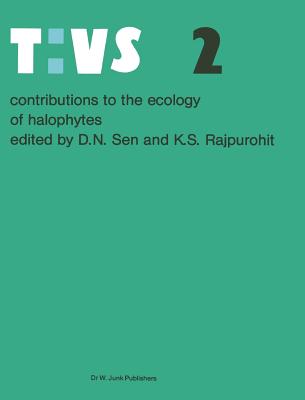
Contributions to the Ecology of Halophytes
Hardcover
Series: Tasks for Vegetation Science, Book 2
ISBN13: 9789061939429
Publisher: Springer Pg
Published: Feb 28 1982
Pages: 272
Weight: 1.79
Height: 0.69 Width: 8.00 Depth: 10.00
Language: English
Also in
Botany & Horticulture
The Light Eaters: How the Unseen World of Plant Intelligence Offers a New Understanding of Life on Earth
Schlanger, Zoë
Hardcover
The Hidden Life of Trees: What They Feel, How They Communicate--Discoveries from a Secret World
Wohlleben, Peter
Hardcover
Floriography: An Illustrated Guide to the Victorian Language of Flowers Volume 1
Roux, Jessica
Hardcover
The Secret Life of Plants: A Fascinating Account of the Physical, Emotional, and Spiritual Relations Between Plants and Man
Bird, Christopher
Tompkins, Peter
Paperback
Paint by Sticker: Dogs: Create 12 Stunning Images One Sticker at a Time!
Workman Publishing
Paperback
Sam Thayer's Field Guide to Edible Wild Plants: Of Eastern and Central North America
Thayer, Samuel
Paperback
Good Nature: Why Seeing, Smelling, Hearing, and Touching Plants Is Good for Our Health
Willis, Kathy
Hardcover
The Drunken Botanist: The Plants That Create the World's Great Drinks: 10th Anniversary Edition
Stewart, Amy
Hardcover
Reference Manual of Woody Plant Propagation: From Seed to Tissue Culture
Dirr, Michael A.
Heuser, Charles W., Jr.
Paperback
How to Forage for Wild Foods Without Dying: An Absolute Beginner's Guide to Identifying 40 Edible Wild Plants
Zachos, Ellen
Paperback
The Ultimate Guide to Houseplant Propagation: Step-By-Step Techniques for Making More Houseplants . . . for Free!
Sisti, Lindsay
Hardcover
Pacific Northwest Medicinal Plants: Identify, Harvest, and Use 120 Wild Herbs for Health and Wellness
Kloos, Scott
Paperback
The Forager's Harvest: A Guide to Identifying, Harvesting, and Preparing Edible Wild Plants
Thayer, Samuel
Paperback
Pacific Northwest Foraging: 120 Wild and Flavorful Edibles from Alaska Blueberries to Wild Hazelnuts
Deur, Douglas
Paperback
Botany for Gardeners, Fourth Edition: An Introduction to the Science of Plants
Capon, Brian
Paperback
Medicinal Plants of the Pacific Northwest: A Visual Guide to Harvesting and Healing with 35 Common Species
Hammerquist, Natalie
Paperback
The Serviceberry: Abundance and Reciprocity in the Natural World (Large Print Edition)
Kimmerer, Robin Wall
Hardcover
Wicked Plants: The Weed That Killed Lincoln's Mother & Other Botanical Atrocities
Stewart, Amy
Hardcover
Plants Have So Much to Give Us, All We Have to Do Is Ask: Anishinaabe Botanical Teachings
Geniusz, Mary Siisip
Paperback
Flowers and Their Meanings: The Secret Language and History of Over 600 Blooms (a Flower Dictionary)
Azoulay, Karen
Hardcover
The Book of Killer Plants: A Field Guide to Nature's Deadliest Creations (a Deadly Field Guide to Lethal Plants)
Carlson, Kit
Paperback
Eat the Weeds: A Forager's Guide to Identifying and Harvesting 274 Wild Foods
Jordan, Deane
Paperback
Midwest Medicinal Plants: Identify, Harvest, and Use 109 Wild Herbs for Health and Wellness
Rose, Lisa M.
Paperback
The Bay Area Forager: Your Guide to Edible Wild Plants of the San Francisco Bay Area
Feinstein, Kevin
Andler, Mia
Paperback
Northeast Ferns: A Field Guide to the Ferns and Fern Relatives of the Northeastern United States
Chadde, Steve W.
Paperback
The Pacific Northwest Native Plant Primer: 225 Plants for an Earth-Friendly Garden
Currin, Kristin
Merritt, Andrew
Paperback
The Essential Book of Succulents: A Guide to the 250 Best Varieties for Beginners
Kuroda, Kentaro
Hardcover
Plants That Kill: A Natural History of the World's Most Poisonous Plants
Larsson, Sonny
Dauncey, Elizabeth A.
Hardcover
Southeast Medicinal Plants: Identify, Harvest, and Use 106 Wild Herbs for Health and Wellness
Shane, Coreypine
Paperback
Wildflowers: Discover the Science and Secrets Behind the World of Wildflowers
Thorogood, Chris
Hardcover
The Light Eaters: How the Unseen World of Plant Intelligence Offers a New Understanding of Life on Earth
Schlanger, Zoë
Paperback
Ashkenazi Herbalism: Rediscovering the Herbal Traditions of Eastern European Jews
Cohen, Deatra
Siegel, Adam
Paperback
A Northern Gardener's Guide to Native Plants and Pollinators
Johnson, Lorraine
Colla, Sheila
Paperback
Nature's Garden: A Guide to Identifying, Harvesting, and Preparing Edible Wild Plants
Thayer, Samuel
Paperback
Flower Finder: A Guide to the Identification of Spring Wild Flowers and Flower Families East of the Rockies and North of the Smokies,
Watts, May Theilgaard
Paperback
Edible Wild Plants: A North American Field Guide to Over 200 Natural Foods
Elias, Thomas
Dykeman, Peter
Paperback
Southeast Foraging: 120 Wild and Flavorful Edibles from Angelica to Wild Plums
Bennett, Chris
Paperback
Gardening Can Be Murder: How Poisonous Poppies, Sinister Shovels, and Grim Gardens Have Inspired Mystery Writers
McDowell, Marta
Hardcover
Northeast Foraging: 120 Wild and Flavorful Edibles from Beach Plums to Wineberries
Meredith, Leda
Paperback
The Gardener's Companion to Medicinal Plants: An A-Z of Healing Plants and Home Remedies
Irving, Jason
Royal Botanic Gardens Kew
Hardcover
Kew - The Magic of Mushrooms: Fungi in Folklore, Superstition and Traditional Medicine
Lawrence, Sandra
Hardcover
Prairie Plants of Illinois: A Field Guide to the Wildflowers and Prairie Grasses of Illinois and the Midwest
Chadde, Steve W.
Paperback
Blackthorn's Book of Sacred Plant Magic: Spells, Rites, and Rituals for Living an Aromatic Life
Blackthorn, Amy
Paperback
The Curanderx Toolkit: Reclaiming Ancestral Latinx Plant Medicine and Rituals for Healing
Garcia Swiecicki, Atava
Paperback
Wildcrafted Fermentation: Exploring, Transforming, and Preserving the Wild Flavors of Your Local Terroir
Baudar, Pascal
Paperback
Plants and Animals in the Yoeme World: Ethnoecology of the Yaquis in Sonora and Arizona
Felger, Richard S.
Molina, Felipe S.
Hardcover
The Green Witch's Herb and Plant Encyclopedia: 150 Ingredients for Everyday Witchcraft
Morgana, Rowan
Paperback
Wildflowers of the Pacific Northwest: Your Way to Easily Identify Wildflowers
Miller, George Oxford
Paperback
California Foraging: 120 Wild and Flavorful Edibles from Evergreen Huckleberries to Wild Ginger
Lowry, Judith Larner
Paperback
The Complete Language of Flowers: A Definitive and Illustrated History - Pocket Edition
Dietz, S. Theresa
Hardcover
Foraging Mushrooms of the Rocky Mountains
Colorado Mycological Society
Pikes Peak Mycological Society
Paperback
Southwest Foraging: 117 Wild and Flavorful Edibles from Barrel Cactus to Wild Oregano
Slattery, John
Paperback
Pacific Intertidal Life: A Guide to Organisms of Rocky Reefs and Tide Pools of the Pacific Coast
Russo, Ron
Olhausen, Pam
Paperback
Foraging: The Ultimate Beginners Guide to Foraging Wild Edible Plants and Medicinal Herbs
Hunt, Jonathan S.
Hardcover
Evolutionary Herbalism: Science, Spirituality, and Medicine from the Heart of Nature
Popham, Sajah
Paperback
Plants That We Eat: Nauriat Nigiñaqtaut - From the Traditional Wisdom of the Iñupiat Elders of Northwest Alaska
Jones, Anore
Paperback
Homeowner's Guide to Training and Pruning Apple Trees: Secrets to Success, From Planting to Maturity
Chadde, Steve W.
Paperback
Flora of Middle-Earth: Plants of J.R.R. Tolkien's Legendarium
Judd, Graham A.
Judd, Walter S.
Hardcover
The Encyclopedia of Rootical Folklore: Plant Tales from Africa and the Diaspora
Samuels, Natty Mark
Hardcover
Kew: The Witch's Garden: Plants in Folklore, Magic and Traditional Medicine
Lawrence, Sandra
Hardcover
Maia Toll's Wild Wisdom Tattoos: 60 Temporary Tattoos Plus 10 Collectible Guided-Ritual Cards
Toll, Maia
Paperback
The Ecology of Herbal Medicine: A Guide to Plants and Living Landscapes of the American Southwest
Saville, Dara
Paperback
The Sierra Forager: Your Guide to Edible Wild Plants of the Tahoe, Yosemite, and Mammoth Regions
Andler, Mia
Paperback
National Geographic Herbal: 100 Herbs from the World's Healing Traditions
Hernandez, Mimi Prunella
Hardcover
Practical Botany for Gardeners: Over 3,000 Botanical Terms Explained and Explored
Hodge, Geoff
Hardcover
Yungcautnguuq Nunam Qainga Tamarmi/All the Land's Surface is Medicine: Edible and Medicinal Plants of Southwest Alaska
Fienup-Riordan, Ann
Paperback
Cacti and Succulents: On-Point Advice to Keep Your Plants Looking Sharp
Gerrard-Jones, Sarah
Hardcover
Southwest Medicinal Plants: Identify, Harvest, and Use 112 Wild Herbs for Health and Wellness
Slattery, John
Paperback
Cruisin' the Fossil Freeway: An Epoch Tale of a Scientist and an Artist on the Ultimate 5,000-Mile Paleo Road Trip
Johnson, Kirk
Paperback


 Sign-In
Sign-In Cart
Cart